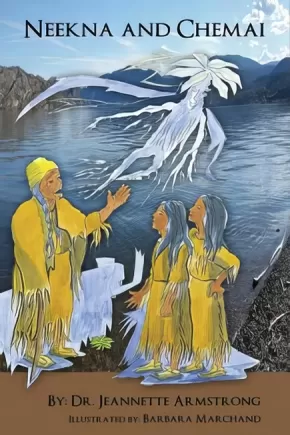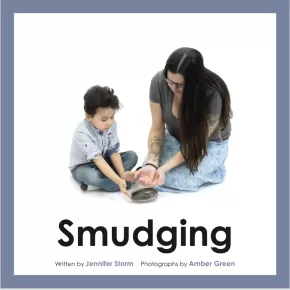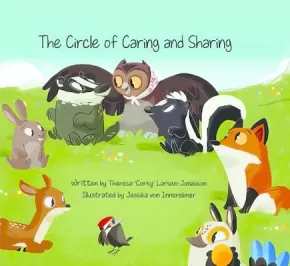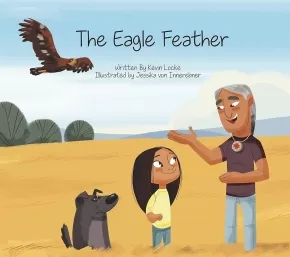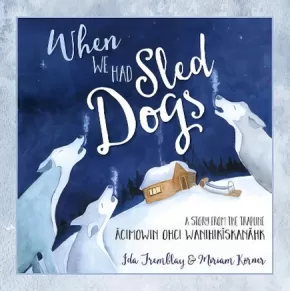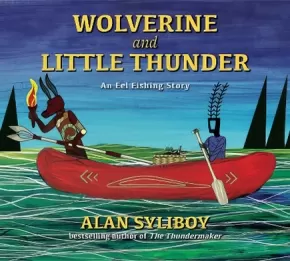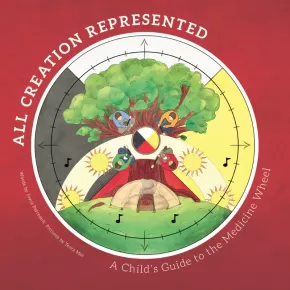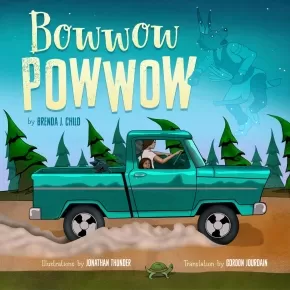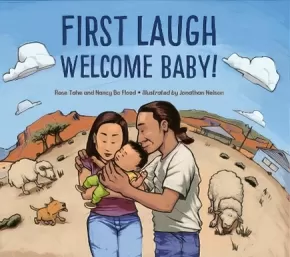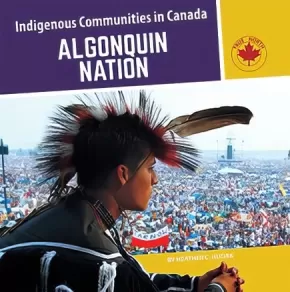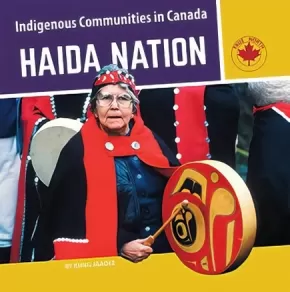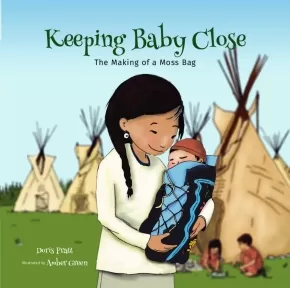
Indigenous Cultural Practices
121
-
135
of
205 Results;
Sort By
Go To
of 14
Neekna and Chemai
$16.95
Artists:
Format:
Paperback
Text Content Territories:
Indigenous Canadian; First Nations; Salish; Interior Salish; Syilx (Okanagan);
ISBN / Barcode: 9781926886435
Synopsis:
Synopsis:
Neekna and Chemai are two little girls growing up in the Okanagan Valley in the time before European contact. Through these two friends, we learn about the seasonal life patterns of the Okanagan First Peoples. The girls spend time with Great-Grandmother, who tells them about important ceremonies, and they gather plants with Neekna's grandmother. Grandmother explains how bitterroot came to be an important food source, and why the people give a special ceremony of thanks at its harvest. Grandmother also tells the story of how a woman was changed to a rock to watch over the Okanagan Valley. Neekna understands how important it is that she has received the knowledge passed down for generations, from great-grandmother to grandmother to mother.
Educator Information
Recommended in the Canadian Indigenous Books for Schools 2019-2020 resource list as being useful for grades 2-7 in these subject areas: Career Education, English Language Arts, Social Studies.
Key Points:
- Learn about the seasonal life patterns of the Okanagan people.
- Armstrong's main goal in writing is to educate young people about Indigenous culture and history.
- Both educator and protector, Jeannette Armstrong is a professor of Indigenous Studies and a Canada Research Chair in Indigenous Philosophy. Her research into Indigenous philosophies and Okanagan Syilx thought and environmental ethics that are coded into Syilx literature has been recognized locally and globally, and she serves as an active member of the Okanagan Nation Alliance and the En’owkin Centre.
Additional Information
52 pages | 5.00" x 7.00" | 3rd Edition
Smudging
$10.00
Artists:
Format:
Paperback
Text Content Territories:
Indigenous Canadian;
ISBN / Barcode: 9781927849637
Synopsis:
Synopsis:
In this story, River and his Auntie demonstrate how to smudge and share why smudging is important.
Educator Information
This book is ideal for reader level K-3.
The Circle of Caring and Sharing
$11.95
Artists:
Format:
Hardcover
Text Content Territories:
Indigenous Canadian; First Nations;
ISBN / Barcode: 9781989122235
Synopsis:
Synopsis:
When two foxes, who are best friends, have a fight it upsets the whole community of animals. Kokom the Owl knows just what to do and brings together all the animals and holds a Sharing Circle.
Educator Information
This book is an adaptation of the book The Sharing Circle for a younger audience (ages 4-6). Explores topics of respect, communication, relationships. Useful social-emotional learning resource.
Includes a page of Plains Cree animals and their phonetic pronunciations at the end of the book.
Recommended in the Canadian Indigenous Books for Schools 2020/2021 resource list as being useful for grades K-3 in these areas: English Language Arts.
This book is available in French: Le cercle d'aide et de partage
Additional Information
32 pages | 9.00" x 8.00"
The Eagle Feather
$11.95
Artists:
Format:
Hardcover
Text Content Territories:
Indigenous American; Native American; Sioux; Lakota; Indigenous Canadian; First Nations; Sioux; Lakota;
ISBN / Barcode: 9781989122228
Synopsis:
Synopsis:
When we look up to the sky and see a beautiful eagle soaring by, we may stop to appreciate its graceful sight, but, as Kevin Locke explains, eagles also have powerful teachings to offer. In this book, Kevin shares with us that each feather on the eagle's wing represents a virtue that we can all learn from.
Educator Information
This book is an adaptation of the book Dawn Flight for a younger audience (ages 4-6). Explores Indigenous ways of knowing and being.
A page at the back of the book includes a few words in Lakota.
Suggested for Ages 4-6.
Recommended in the Canadian Indigenous Books for Schools 2020/2021 resource list as being useful for grades K-2 in this area: Social Studies.
This book is available in French: La plume d'aigle
Additional Information
26 pages | 9.00" x 8.00"
The Song Within My Heart (PB) (6 in Stock)
$16.95
Artists:
Format:
Paperback
Text Content Territories:
Indigenous Canadian; First Nations; Cree (Nehiyawak);
ISBN / Barcode: 9780889955721
Synopsis:
Synopsis:
Listen to the beating drum
It tells a hundred stories
Of our people, of our homeland
Some of birds and beasts and sweet grass.
Close your eyes and listen
You might come to hear a story
That no one hears but you alone
A story of your very own.
Renowned Cree painter Allen Sapp's inspired and stunning artwork beautifully complements this sweet story of a young First Nations boy preparing for his first pow-wow. The young boy's Nokum—his beloved grandmother—guides him through the exciting day and watches over him as events unfold. David Bouchard's rhythmic and informative text is based on remembrances from Allen Sapp's childhood.
Winner of the Governor General's Literacy Award, The Song Within My Heart is a beautifully crafted picture book that refects the wonders of life on a reserve, the importance of the pow-wow, and ultimately, the love between grandmother and grandson.
Reviews
"Sapp's illustrations, rendered in thickly textured oil paint, emphasize the bond and love that the boy feels for his grandmother. The sense of emotional connection to a powwow is portrayed through the spare, poetic text. . . A strong offering about powwows, familial love, and finding understanding from within."— School Library Journal
"A heartfelt intergenerational story about knowing and preserving heritage and love between elders and young ones. . . Bouchard's rhythmic text successfully conveys an emotive and sensory approach to the relationship between the two, enriching the story and echoing the hand-lettered onomatopoeic syllables that represent chanting and drumbeats. Sapp's profound paintings bring sincere and reassuring images that support and enhance the tale. A stunning picture book that celebrates life, family relations, and determination to preserve traditions and heritage."— Kirkus Starred Review
"Based on Cree painter Allen Sapp's childhood memories of life on a reserve in Saskatchewan, The Song Within My Heart tells of a young boy who is getting ready to go to a pow wow. Woven throughout the story is the boy's close relationship with his Nokum (grandmother). Bouchard's lyrical text, with its thoughtfully chosen words, evokes a quiet, introspective mood. Richly textured and infused with an almost radiant light quality, the illustrations reinforce strongly the simplicity of life on a reserve, the significance of the pow wow and, of course, the love between grandmother and grandson. Beautifully crafted. Highly Recommended." — CM Magazine
Educator Information
Recommended for ages 8-12
Bilingual: Cree/English
Additional Information
32 pages | 10.00" x 7.25"
When We Had Sled Dogs: A Story from the Trapline - ācimowin ohci wanihikīskanāhk (HC) (4 in Stock)
$22.95
Artists:
Format:
Hardcover
Text Content Territories:
Indigenous Canadian; First Nations; Cree (Nehiyawak);
ISBN / Barcode: 9781988783390
Synopsis:
Synopsis:
When We Had Sled Dogs: A Story from the Trapline - ācimowin ohci wanihikīskanāhk takes readers young and old on a journey into the past when dog teams were part of the traditional way of life in Northern Saskatchewan. Inspired by Elder Ida Tremblay’s childhood memories, and told in English with Woodland Cree words and phrases, the story follows the seasonal cycle of trapline life.
Educator Information
Recommended for ages 5 - 10.
Delivered in English with Woodland Cree words and phrases.
This resource is recommended in the Canadian Indigenous Books for Schools 2020/2021 resource list for grades K to 4 for use in these areas: Social Studies, English Language Arts, and Career Education.
Additional Information
|
Wolverine and Little Thunder: An Eel Fishing Story (PB) (2 in stock, In reprint )
$14.95
Artists:
Format:
Paperback
Text Content Territories:
Indigenous Canadian; First Nations; Mi'kmaq;
ISBN / Barcode: 9781774710906
Synopsis:
Synopsis:
Celebrated Mi'kmaw artist behind The Thundermaker returns with a story about friendship and the importance of traditional knowledge.
From the bestselling creator of The Thundermaker comes another adventure featuring Little Thunder and Wolverine — a trickster, who is strong and fierce and loyal. The two are best of friends, even though Wolverine can sometimes get them into trouble. Their favourite pastime is eel fishing, whether it's cutting through winter ice with a stone axe or catching eels in traditional stone weirs in the summer. But that all changes one night, when they encounter the giant river eel — the eel that is too big to catch. The eel that hunts people!
At once a universal story of friendship and problem-solving, Wolverine and Little Thunder is a contemporary invocation of traditional Mi'kmaw knowledge, reinforcing the importance of the relationship between the Mi'kmaq and eel, a dependable year-round food source traditionally offered to Glooscap, the Creator, for a successful hunt.
Educator Information
Recommended ages: 4-8
Additional Information
40 pages | Paperback
All Creation Represented: A Child's Guide to the Medicine Wheel
$16.95
Artists:
Format:
Paperback
Text Content Territories:
Indigenous Canadian; First Nations; Anishinaabeg; Ojibway;
ISBN / Barcode: 9780995012714
Synopsis:
Synopsis:
All Creation Represented is a child’s guide to the Medicine Wheel. Told from an authentic perspective of an Anishinaabe / Ojibwe knowledge holder, Joyce Perreault skillfully weaves together traditional teachings with modern educational goals, making this book an excellent resource for children of all ages.
The Medicine Wheel is a foundation of teaching and learning that shows how different parts of life are connected and balanced. Many generations of Indigenous cultures have understood the world through Medicine Wheel teachings. The Medicine Wheel offers holistic and relational ways of understanding the self, the family, the community, the natural and spiritual world. The book introduces the concept of a Medicine Wheel, highlighting the significance of the associated ancestral teachings as it discusses various aspects of human well-being, the physical world, and Indigenous culture. This book is designed as an education resource and embodies First Peoples Principles of Learning.
Learn the Ojibwe words that are represented by various aspects of the Medicine Wheel with a glossary at the back of the book, and explore a way of looking at the world that is holistic, sacred, and powerful. All Creation Represented will help readers consider the wisdom and knowledge of the First Peoples who used the Medicine Wheel to teach about and understand the world around them.
Educator Information
This book is designed as an education resource and embodies First Peoples Principles of Learning.
Additional Informaiton
32 pages | 8.25" x 8.25"
Bowwow Powwow
$25.00
Format:
Hardcover
Text Content Territories:
Indigenous American; Native American; Anishinaabeg; Ojibwe (Chippewa);
ISBN / Barcode: 9781681340777
Synopsis:
Synopsis:
Windy Girl is blessed with a vivid imagination. From Uncle she gathers stories of long-ago traditions, about dances and sharing and gratitude. Windy can tell such stories herself–about her dog, Itchy Boy, and the way he dances to request a treat and how he wriggles with joy in response to, well, just about everything.
When Uncle and Windy Girl and Itchy Boy attend a powwow, Windy watches the dancers in their jingle dresses and listens to the singers. She eats tasty food and joins family and friends around the campfire. Later, Windy falls asleep under the stars. Now Uncle's stories inspire other visions in her head: a bowwow powwow, where all the dancers are dogs. In these magical scenes, Windy sees veterans in a Grand Entry, and a visiting drum group, and traditional dancers, grass dancers, and jingle-dress dancers–all with telltale ears and paws and tails. All celebrating in song and dance. All attesting to the wonder of the powwow.
This playful story by Brenda Child is accompanied by a companion retelling in Ojibwe by Gordon Jourdain and brought to life by Jonathan Thunder's vibrant dreamscapes. The result is a powwow tale for the ages.
Awards
- 2020 American Indian Youth Literature Award winner for Picture Book
- 2019 American Library Association Notable Children’s Book
- 2019 Cooperative Children’s Book Center Best of the Year Choice
- 2018 American Indians in Children’s Literature Best Books
Educator Information
Recommended for ages 3 to 7.
Dual-language: Ojibwe and English
Additional Information
32 pages | 10.00" x 10.00" | Hardcover
First Laugh — Welcome, Baby!
$21.99
Format:
Hardcover
Text Content Territories:
Indigenous American; Native American; Navajo (Diné);
Grade Levels: Preschool; Kindergarten;
ISBN / Barcode: 9781580897945
Synopsis:
Synopsis:
In Navajo families, the first person to make a new baby laugh hosts the child's First Laugh Ceremony. Who will earn the honor in this story?
The First Laugh Ceremony is a celebration held to welcome a new member of the community. As everyone--from Baby's nima (mom) to nadi (big sister) to cheii (grandfather)--tries to elicit the joyous sound from Baby, readers are introduced to details about Navajo life and the Navajo names for family members. Back matter includes information about other cultural ceremonies that welcome new babies and children, including man yue celebration (China), sanskaras (Hindu) and aquiqa (Muslim).
Reviews
"In Navajo families, a baby’s first laugh is more than a developmental milestone—it’s an honor to be the first person who makes the baby laugh, and the event is commemorated with a joyous gathering called the First Laugh Ceremony. The baby in this story, however, is making the family work for his giggles. “Your mouth open wide... It stretches... A smile? Oh, no. It’s a sleepy pink yawn,” write Tahe (a Navajo educator who died in 2015) and Flood (Cowboy Up! Ride the Navajo Rodeo). Not even baby’s ninaai (big brother), with his silly faces, can coax a grin. Then one day, cheii (grandfather) holds the baby high in the air, nima-sani (grandmother) whispers a traditional prayer, and “like babies everywhere—long ago and today—you laugh!” Debut illustrator Nelson, also of Navajo descent, contributes cartooning that captures an expansive, brilliantly hued outdoors and a close-knit family delighted with their newest addition. An extensive afterword gives more information on the ceremony as well as on baby celebrations in other cultures." — Publisher's Weekly
Educator Information
Recommended Ages: 2-5
Includes information about other cultural ceremonies that welcome new babies and children, making this a great resource for discussions of diversity and cultures around the world.
Additional Information
| 32 pages | 8.88" x 9.91" |
Indigenous Communities in Canada: Algonquin Nation (4 in Stock)
$14.95
Format:
Paperback
Text Content Territories:
Indigenous Canadian; First Nations; Anishinaabeg; Algonquin;
ISBN / Barcode: 9781773083827
Synopsis:
Synopsis:
A book about the Algonquin Nation.
Educator & Series Information
This book is part of the Indigenous Communities in Canada series.
Additional Information
24 Pages
Indigenous Communities in Canada: Haida Nation
$14.95
Format:
Paperback
Text Content Territories:
Indigenous Canadian; First Nations; Haida;
ISBN / Barcode: 9781773083841
Synopsis:
Synopsis:
A book about the Haida Nation.
Educator & Series Information
This book is part of the Indigenous Communities in Canada series.
Additional Information
24 Pages
Indigenous Peoples Atlas of Canada
$99.99
Format:
Hardcover
Text Content Territories:
Indigenous Canadian; Métis; Inuit; First Nations;
ISBN / Barcode: 9780986751622
Synopsis:
Synopsis:
Indigenous perspectives much older than the nation itself shared through maps, artwork, history and culture.
The Royal Canadian Geographical Society, in partnership with Canada's national Indigenous organizations, has created a groundbreaking four-volume atlas that shares the experiences, perspectives, and histories of First Nations, Inuit and Métis peoples. It's an ambitious and unprecedented project inspired by the Truth and Reconciliation Commission's Calls to Action. Exploring themes of language, demographics, economy, environment and culture, with in-depth coverage of treaties and residential schools, these are stories of Canada's Indigenous Peoples, told in detailed maps and rich narratives.
This extraordinary project offers Canada a step on the path toward understanding.
The volumes contain more than 48 pages of reference maps, content from more than 50 Indigenous writers; hundreds of historical and contemporary photographs and a glossary of Indigenous terms, timelines, map of Indigenous languages, and frequently asked questions. All packaged together in a beautifully designed protective slipcase.
Educator Information
Recommended for ages 13+.
The Indigenous Peoples Atlas of Canada includes a four volume print atlas, an online atlas, an app, and more!
Additional Information
322 pages | 10.50" x 12.87"
Keeping Baby Close: The Making of a Moss Bag
$10.00
Artists:
Format:
Paperback
Text Content Territories:
Indigenous Canadian;
Reading Level: N/A
ISBN / Barcode: 9781927849538
Synopsis:
Synopsis:
The moss bags of the Plains Indians kept babies safe, content, and part of daily life. This two-part book first explores the features and purpose of moss bags, along with softly coloured illustrations. The second part includes step-by-step directions for making a moss bag, accompanied by explanatory photos. Discover more about moss bags, the ingenious creation of early mothers and grandmothers living close to Mother Earth.
Educator Information
Juvenile Nonfiction
Sharing Our Truths / Tapwe
$19.95
Artists:
Text Content Territories:
Indigenous Canadian; First Nations; Cree (Nehiyawak);
ISBN / Barcode: 9781927083529
Synopsis:
Synopsis:
Join the authors as they lead the children through important Cree cultural experiences, tell stories, and share their wisdom and truths with compassion. Learn the protocols for building a tipi, trapping a beaver, laying the grandfather stones for a fire, smudging, and harvesting salt from the Salt Plains in Wood Buffalo National Park. In Cree, tapwe means "it is so" or "the truth." In this, Henry writes, "We can tell you what to do with the truths we share in this book, but we hope that reading our story will help you get to know us a little better so that together we can make this nation a place we can all be proud of."
Reviews
"An intimate gateway to learning about the Cree First Nations people from the perspective of its elders." - Kirkus Reviews
Educator & Series Information
Recommended for Ages 8-12.
This is the 9th book in the This Land Is Our Storybook series, which considers the diverse lands and cultures of Canada's Northwest Territories. Told in a uniquely diverse range of northern voices, with a child-centred approach, books in the series highlight each official Aboriginal language group in the NWT, revealing a richly textured picture of life in the North--on the trapline, around the campfire, in communities, at school, and within the outdoor school that is the land itself. The series celebrates the seasons, ages, genders, traditional activities, and communities of the NWT.
The stories are illustrated by the striking images of acclaimed northern photographer, Tessa Macintosh and depict the similarities in lifestyle between children of the North and South, as well as the marked cultural differences, and highlight the special relationship these First Nations people have with the land and how they are adapting to rapid change while remaining connected to the land. Images of the landscape and animals within it, of trapping, hunting, fishing, and bannock baking sit alongside pictures of children at school, swimming at recreation centres, and reading in libraries. Here is modern northern culture painted beautifully: a complex mix of the new and the old.
These wonderful books, written with a variety of provincial and territorial curricula in mind, are specially designed for the classroom and include special features such as glossaries relating details on animals biology and cultural definitions, regional and language maps. The text of the stories also have sidebars such as Our Stories, which contain the stories of the people and language group featured, and Our Words, which highlight words in the featured language that are important to the story.
Additional Information
36 pages | 8.00" x 8.00" | Library Binding
Sort By
Go To
of 14

